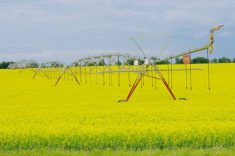For three-times-daily market reports from Don Bousquet and RNI, visit “ICE Futures Canada updates” at www.manitobacooperator.ca
Grain and oilseed prices at ICE Futures Canada in Winnipeg closed the week ended Jan. 29 lower. Canola was pressured down by losses in the U. S. soy complex, bearish technical signals and steady farmer selling as producers have become disappointed with prices. The losses came despite the fact that Pakistan picked up two cargoes of canola, the Canadian dollar fell and open interest rose to its highest level since the Chinese placed an embargo on Canadian canola imports that can’t be proven to be blackleg free. Commercials dominated the trade, with speculators going heavily short the canola expecting further declines. Western barley posted small losses in thin activity.
Read Also

Manitoba sclerotinia picture mixed for 2025
Variations in weather and crop development in this year’s Manitoba canola fields make blanket sclerotinia outlooks hard to pin down
U. S. corn and soybean futures also fell, with just small declines in corn and moderate losses in soybeans. Soybeans were pressured lower by the favourable outlook for the South American soybean crops and by bearish technical signals. A firmer U. S. dollar also weighed on prices. Export demand remained better than expected and that underpinned the market. Corn futures posted small losses on some enthusiasm in demand for U. S. corn, notably from the ethanol industry. The main negative continues to be the very large U. S. corn supply. Technically based selling was also noted.
U. S. wheat futures continued to post losses that began with the Jan. 12 U. S. Department of Agriculture supply/demand reports. The U. S. markets continue to be overpriced and the world continues to see oversupply of wheat with no major threat to the world wheat supply.
CANADA CONFIRMS
Agriculture and Agri-Food Canada brought out its latest supply/demand report last week and confirmed that the global oilseed and grain markets are firmly a buyers’ market, and farmers are going to struggle with poorer prices until Mother Nature decides to change the supply/ demand balances or until “low prices cure low prices.” The report showed that with the exception of oats, all ending stocks for 2009-10 of grains and oilseeds rose, some of them quite substantially.
However, there are signs that this move from oversupply is slowly happening. Last week I did look at the slow improvement in the wheat situation. It will be a slow trimming of the large wheat supply and will reflect farmers backing away from planting. We will also have to see greater production discipline from the states of the former Soviet Union.
The large production taking place in the Black Sea region is being absorbed globally as Russia, Ukraine and Kazakhstan sell off their wheat at fire-sale prices, depressing markets. However, there is some question about the wheat’s quality, which will favour high-quality wheat such as Canada’s.
In the U. S., we are starting to see a similar situation develop for corn. The cheap price for corn has stimulated increased demand for ethanol. Currently 107 million tonnes (mostly corn) are being used for ethanol production, but U. S. demand calls for another five million gallons of ethanol to be produced within the year.
On top of that, China is short of corn and has started to import dried distillers grains (DDGs, the livestock feed byproduct of ethanol) in order to boost China’s meat production.
BOOST FOR BIOFUEL
I don’t know if you noticed it or not, but U. S. President Barack Obama, in his State of the Union address Jan. 27, made encouraging statements about increased biofuel production. While he couched it in terms about global warming, he was actually talking about increased labour demand with good-paying jobs. The ethanol companies heard the reference, and they were talking about building new plants and creating new high-paying jobs the next day.
These are all signs that cheaper prices are encouraging increased demand.
When it comes to oilseeds, the same thing exists. Poor prices caused by the record South American soybean crop have resulted in U. S. soybean prices being even lower, which has resulted in heavier bookings of U. S. supplies of soybeans.
It has spilled into the Canadian market, where Pakistan bought two cargoes of Canadian canola as well as canola from Australia. There are also rumours of buying of Canadian canola by Dubai in recent weeks.
The buying of canola by Dubai was felt to reflect demand for canola oil by China. China’s demand for canola meal and oil is stronger than expected. Because they won’t import canola unless it is certified blackleg free, they have been bringing in canola byproducts from Dubai made from Canadian canola, as blackleg does not show up in the oil or meal.
It quite amazes me how people can rationalize these things. But this proves that cheap prices will overcome government bureaucracies.
So as you can see, the low prices are curing the low prices by stimulating demand. Also be aware that low prices will lead to lower acres ultimately.
The grain trade, though, does not want to see any drop in canola area and is actually looking for higher area. No one expects that Canadian farmers can pull off another year of amazing yields on poor growing conditions.
To encourage the higher acres, watch for various company programs offering you amazing deals on inputs and marketing plans. I am already hearing of some plans that are too hard to believe when compared to some of the programs offered in the past.
– Don Bousquet is a well-known market analyst and president of Resource News
International (RNI), a Winnipeg company specializing in grain and commodity market reporting.

















